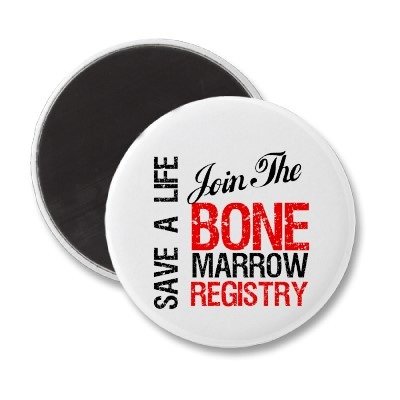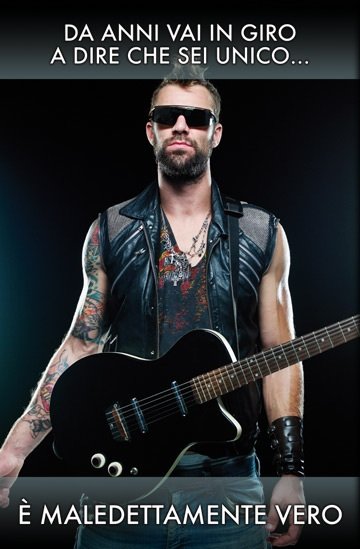Clicca qui per saltare alla spiegazione italiana
A lot of people have been asking about getting on the bone marrow registry, which is fabulous to hear as the more people who sign up, the more chance anyone needing a match (such as, I don’t know, a relapsed ALL patient) will do so. As the Anthony Nolan Trust explains:
For many people suffering from a blood cancer, such as leukaemia, a blood stem cell transplant may be their last chance of life.
All blood cells originate in the bone marrow from the same type of cell, called a blood stem cell. A blood stem cell, or bone marrow, transplant can replace a damaged immune system in a person with blood cancer – but only if the donor’s cell type matches.
 I am touched and grateful to know that many of you want to be tested to see if you are a match with me. However, as the chances of any one individual being a match with another are minuscule (unless they are siblings), this means that the only feasible way to put yourself forward as a potential match is to sign up to one of the bone marrow registries. If — absolutely against the odds — you do happen to be a great match with me, the doctors here would be able to see that on the international database as soon as you register.
I am touched and grateful to know that many of you want to be tested to see if you are a match with me. However, as the chances of any one individual being a match with another are minuscule (unless they are siblings), this means that the only feasible way to put yourself forward as a potential match is to sign up to one of the bone marrow registries. If — absolutely against the odds — you do happen to be a great match with me, the doctors here would be able to see that on the international database as soon as you register.
Most importantly, though, you might one day be able to help someone, somewhere in a situation like mine; this means a huge amount to me — and could save someone’s life.
What does it involve?
- Signing up does not involve anything invasive (either a saliva sample or some extra blood taken when giving blood, which is also a VERY GOOD THING TO DO)
- However, make sure you read about what you would need to do if you are a match one day with someone and proceed to stem cell donation. Information is available on the websites of both UK registers; please make sure you would be potentially comfortable to go through with the donation before signing up.
How do I sign up?
In the UK, there are two possibilities, with differing requirements:
- Anthony Nolan — aged 16-30, weighing over 50kg
Anthony Nolan is a charity and has decided to focus its resources on the donor group most likely to provide the best matches - British Bone Marrow Registry — aged 18-49, must be a blood donor
This is run by the NHS, but the database is used by Anthony Nolan when looking for matches. You can sign up at your first blood donation, too.
I’m not in the UK
Each country has its own register, which you should be able to track down on Google; much as I’d love to find and list them all, I think I can leave that in your hands…
THANK YOU!
La spiegazione italiana – grazie tanto ad Ida!
 Il trapianto allogenico di midollo osseo consiste nella reinfusione di cellule staminali del midollo osseo di un donatore (il soggetto sano) in un ricevente (il soggetto malato) dopo che il ricevente è stato “preparato” con la somministrazione di chemioterapia e/o radioterapia ad alta intensità.
Il trapianto allogenico di midollo osseo consiste nella reinfusione di cellule staminali del midollo osseo di un donatore (il soggetto sano) in un ricevente (il soggetto malato) dopo che il ricevente è stato “preparato” con la somministrazione di chemioterapia e/o radioterapia ad alta intensità.
Individuare un donatore idoneo per poter procedere al trapianto significa verificare che le cellule dell’uno e dell’altro siano compatibili, in modo da limitare il rischio della condizione nota come Graft Versus Host Disease (GVHD), cioè quella condizione in cui linfociti del donatore colpiscono i tessuti del ricevente, non riconoscendoli.
A causa della grande variabilità tra un individuo ed un altro al di fuori dell’ambito familiare, sono stati creati dei Registri Internazionali di Donatori Volontari di Midollo Osseo.
Qualunque individuo di età compresa tra i 18 anni e i 35 anni, che abbia un peso corporeo superiore ai 50 kg, può diventare donatore di midollo purché, non sia affetto da malattie del sangue, da malattie croniche gravi o da altre gravi forme infettive (AIDS, epatite, ecc.). Il prelievo non è rischioso e avviene in anestesia.
Per informazioni più dettagliate, visitate il sito dell’Associazione Italiana Donatori di Midollo Osseo.
Per iscriversi al Registro Donatori di Midollo Osseo è necessario presentarsi, senza impegnativa medica, presso un Centro Donatori per sottoporsi al prelievo di un campione di sangue periferico e per firmare il consenso all’ iscrizione al Registro.
A Napoli ci si può rivolgere al Servizio di Immunoematologia e Medicina Trasfusionale della Seconda Università di Napoli o a quello di Immunoematologia e Medicina Trasfusionale della Federico II (Policlinico Nuovo).
GRAZIE!


I just found your blog, George. You are a super hero! Stay strong! I just celebrated six months post-transplant for AML and am very familiar with the path you’re on. Keep up the positive spirit and fight on!
Friend of Harriet and Duncan’s here….inspirational blog chap – it sounds like you’ve got absolutely the right attitude going here. I can vouch for the bone marrow registry – twice I’ve been asked to provide samples, twice I haven’t matched, but I will keep on trying to help where I can!
Keep strong, and stay happy.
G